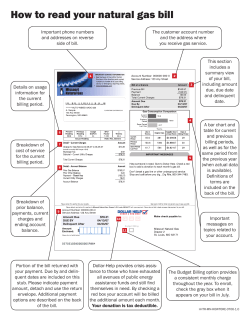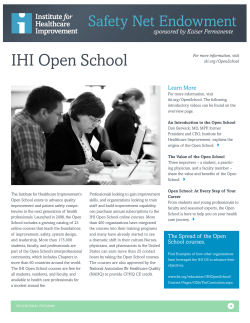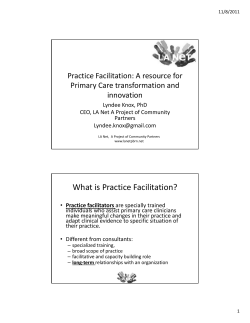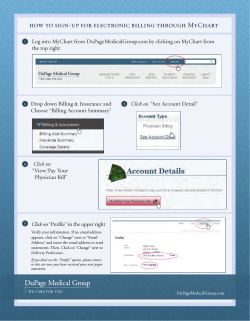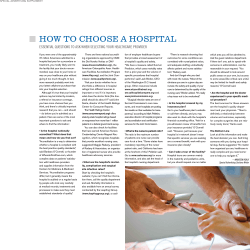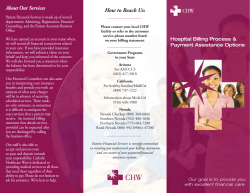
Obstacles to Improving Quality of Care and How to Overcome Them
Obstacles to Improving Quality of Care and How to Overcome Them Judy Ringholz, RN, JD, CHC jringholz@sonnenschein.com 202-408-5305 HCCA 13th Annual Compliance Institute April 26-29, 2009 Las Vegas, Nevada Preventing Adverse Events and Never Events 2 1 AHRQ, The Patient Safety Act and Patient Safety Organizations (PSOs) • Per AHRQ's Patient Safety Organization Web Site: • The Patient Safety and Quality Improvement Act of 2005 (Patient Safety Act) authorized the creation of Patient Safety Organizations (PSOs) to reduce the incidence of events that adversely affect patients. • PSOs are designed to improve the quality and safety of U.S. health care by encouraging clinicians and health care organizations to report and share—voluntarily—data on patient safety events without fear of legal discovery. • The Agency for Healthcare Research and Quality (AHRQ) administers the provisions of the Patient Safety Act dealing with PSO operations. 3 AHRQ, The Patient Safety Act and Patient Safety Organizations (PSOs) • Per AHRQ's Patient Safety Organization Web Site: • In 1999, the Institute of Medicine (IOM) issued a landmark report entitled, "To Err is Human: Building a Safer Health System," which highlighted critical areas of research and activities needed to improve the safety and quality of health care delivery. One critical area of the IOM report addressed the reporting and analysis of data on adverse events. • The IOM report and its findings spotlighted a serious need to capture data that would help to reduce harm to patients. Addressing this need, Congress passed The Patient Safety and Quality Improvement Act of 2005 (Patient Safety Act). The Patient Safety Act authorizes the creation of Patient Safety Organizations (PSOs) to improve safety and quality through the collection and analysis of data on patient events. 4 2 AHRQ, The Patient Safety Act and Patient Safety Organizations (PSOs) • Per AHRQ's Patient Safety Organization Web Site: • PSOs are organizations that share the goal of improving the safety and quality of health care delivery. Organizations that are eligible to become PSOs include: public or private entities, profit or not-for-profit entities, provider entities such as hospital chains, and other entities that establish special components to serve as PSOs. • By providing both privilege and confidentiality, PSOs create a secure environment where clinicians and health care organizations can collect, aggregate, and analyze data that enable the identification and reduction of risks and hazards associated with patient care. 5 Network of Patient Safety Databases • 11/21/08, HHS Final Rule (effective January 19, 2009) created a system of voluntary reporting to Patient Safety Organizations (PSOs) • Designed to complement the 2005 PSQIA (Pub.L.No. 109-41; S. 544) • As data becomes available from PSOs, a Network of Patient Safety Databases (NPSD) will receive, analyze, and report on de-identified and aggregated patient safety event information. • The goal of the NPSD is to facilitate aggregation and analyses of patient safety event information to help reduce adverse events and improve health care quality. 6 3 PSOs may use different approaches to reducing adverse events: • • • • • • Collect data on the prevalence and details of errors. Analyze sources of error by root cause analysis. Propose and communicate methods for error prevention. Design and conduct pilot projects to study safety initiatives. Raise awareness of patient safety issues and recommendations. Conduct fundraising and obtain funding for research and safety projects. • Advocate for regulatory and legislative changes. 7 Private Organizations: • • • • • • • • • • • • American Society of Medication Safety Officers The National Quality Forum Leapfrog The Joint Commission The Pittsburgh Regional Health Initiative The Institute for Healthcare Improvement (IHI) The National Patient Safety Foundation The United States Pharmacopeia (USP) Institute for Safe Medication Practices Safe Care Campaign TMIT ECRI Institute 8 4 The Joint Commission – 2009 Patient Safety Goals: • • • • • • • • • Improve the accuracy of patient identification. Improve the effectiveness of communication among caregivers. Improve the safety of using medications. Reduce the risk of health care associated infections. Accurately and completely reconcile medications across the continuum of care. Reduce the risk of patient harm resulting from falls. Encourage patients’ active involvement in their own care as a patient safety strategy. The organization identifies safety risks inherent in its patient population. Improve recognition and response to changes in a patient’s condition. 9 Institute for Healthcare Improvement (IHI) • The Institute for Healthcare Improvement (IHI) is an independent not-for-profit organization. Its mission is to improve quality in healthcare. • “We aim to improve the lives of patients, the health of communities, and the joy of the health care workforce by focusing on an ambitious set of goals adapted from the Institute of Medicine's six improvement aims for the health care system: Safety, Effectiveness, Patient-Centeredness, Timeliness, Efficiency, and Equity.” • Founded in 1991 and based in Cambridge, Massachusetts • Funded primarily through its own fee-based program offerings and services • Also through support offered by foundations, companies, and individuals 10 5 Institute for Healthcare Improvement (IHI) • Timeline • IOM: “To Err is Human” • Estimated that as many as 98,000 deaths a year were attributable to medical errors • Recommended that error-related deaths be decreased by 50 percent over five years [Goal not obtained – See next slide] • Strategic Initiatives • Pursuing Perfection • Transforming Care at the Bedside • Results • Care • Flow • Patient Safety • White Papers • Engaging Physicians in a Shared-Quality Agenda 11 Never Events • On May 18, 2006, CMS announced that it was investigating ways that Medicare can help to reduce or eliminate the occurrence of “never events” – serious and costly errors in the provision of health care services that should never happen • Such events are known to cause serious injury or death to patients and result in increased costs to the Medicare program to treat the consequences of the error • List of 28 Never Events developed by the National Quality Foundation (NQF) with support from CMS • Hospital Acquired Conditions (HAC) – discussed previously • Some states have enacted legislation requiring mandatory reporting 12 6 Process Improvements 13 Process Improvements • Proactive steps to prevent “never event” exposure: • Designate “never events” response team; include physician leadership, compliance officer, nursing leadership, operations management, quality and risk management, legal, HIM and Finance (allow for ad hoc involvement) • Revisit sentinel events policies; assure all “never events” are included • Assure policy addresses record security and confidentiality and places a hold or flag on the patient’s account 14 7 Process Improvements • Post policies and response team contacts on nursing units/OR areas, etc. • Increase awareness of “never events,” POA, HACs among all staff – include as part of new hire orientation – focus on patient safety and prevention • Assure all associates are aware of reporting “never events,” as soon as possible, to enact “never event” response team • Assure appropriate forms or occurrence reports are updated and available for use pursuant to policies and procedures 15 Process Improvements • If event occurs: • Establish time frames for investigation and report completion • Perform a root cause analysis • Assure event is documented in the medical record • Have a discussion with the patient • Develop action plan to avoid recurrence 16 8 Financial Policies • Bill holds are critical • Quality and risk management, compliance officer and legal determine accounts to write-off; use a case-by-case approach • Write-off transaction codes for HACs and “never events” should be unique in order to track the amounts individually and as a combination • Demonstrates impact quality has on bottom line 17 Assessments to Enhance Quality and Compliance 18 9 Why are Assessments Critical for Hospitals Today? • Quality is now one of the top compliance issues for hospitals today • Many Hospitals are unaware of their compliance vulnerabilities related to quality because they have not subjected their quality of care processes to the same scrutiny they devote to other compliance concerns (i.e. billing/claims submission; physician financial relationships) • OIG 2009 Work Plan emphasizes quality as an enforcement priority • Data Mining, RAC and other government initiatives increase the risk of enforcement based on quality failures 19 The Team: Legal/compliance and clinical/operations • Recognize that assessments to enhance quality of care require both legal/compliance and clinical/operational expertise. Develop a streamlined approach • Assessments should be performed under attorney/client privilege • Specific focus on the compliance risks raised by quality issues • Adjust structures and processes to address quality of care and compliance issues proactively to avoid costly and public enforcement actions 20 10 What Does the Assessment Accomplish? • Streamlined approach to assess quality controls and legal risks • Look at Medicare COP requirements, fraud and abuse risks, quality data reporting processes, HAC and Never Events compliance, Medical Necessity requirements and processes, OIG work plan, data mining, State Medicaid enforcement, etc. • Bring together billing and quality issues and filter through a compliance lens to provide a global risk assessment and compliance endeavor 21 Post-Assessment Process • The assessment is likely to identify specific areas of process gaps, quality control weaknesses and fraud and abuse risks • The organization will be in a position to develop a structured plan to address the issues • If engaged, outside counsel/consultants would be available to help with corrective action planning or implementation 22 11 Traditional Approach to Integration of Quality and Compliance • Compliance professionals should conduct an annual quality risk assessment of the areas included in the OIG’s work plan, all “never events” and the CMS “present on admission” areas to ensure that Medicare and Medicaid billing is appropriate (Conduct in concert with the Chief Quality Executive and Chief Patient Safety Executive) • Ongoing monitoring of these areas is critical. • A joint quality and compliance “work plan” should be created based on the gaps unveiled by the risk assessment: 23 Training on Quality and Compliance • Board training is required • Sensitizing senior and line management to CMS and OIG’s focus is critical • Training clinicians on how to document and code services (and when they cannot bill) is imperative • Involve Medical Staff Leadership in the curriculum and training imperative: let them lead the charge 24 12 Integrating Quality and Compliance • Policies and education to address compliance risks associated with quality • Need to investigate compliance implications of quality failures. • Reporting procedures need to be established. • Be careful to maintain the privilege 25 Problems Under Current Structures – Silo Approach PEER REVIEW QUALITY RISK UTILIZATION REVIEW COMPLIANCE BILLING 26 13 Process Improvements Integration II Quality Risk Utilization Review Billing Compliance Peer Review 27 Summary of Quality and Compliance Goals • Establish an infrastructure to provide an environment that supports quality and patient safety across the continuum • Establish an infrastructure with controls and processes in place to mitigate compliance risks as they relate to quality of care • Standardize clinical practices based on evidenced-based medicine • Improve efficiency and eliminate waste in hospital systems/processes • Align physician and hospital practices around quality of care • Financially align physician and hospital incentives to support quality of care 28 14 Compliance/Quality Basics In Summary • Comprehensive Assessments • A baseline assessment should be conducted to identify compliance risks related to quality of care and patient safety issues • All key stakeholders should be involved in the assessment including the medical staff and Board of Directors • Monitoring • Identify areas of risk along with recommended best practices • Prioritize risk areas based on organizational needs • Education and Training • Develop mandatory training modules to address quality, patient safety and compliance obligations 29 Conclusion • Focus on compliance implications of quality of care and patient safety system/process failures • Transition from the silo approach to an integrated approach of quality, patient safety, risk and compliance 30 15 16
© Copyright 2025
